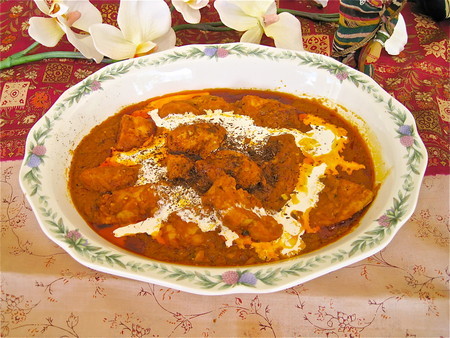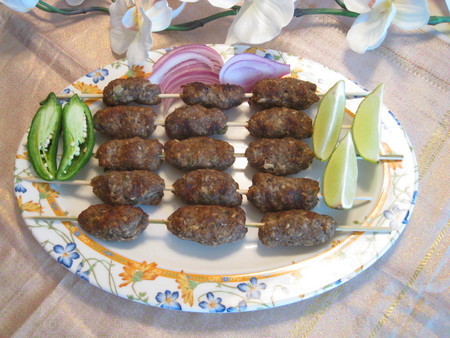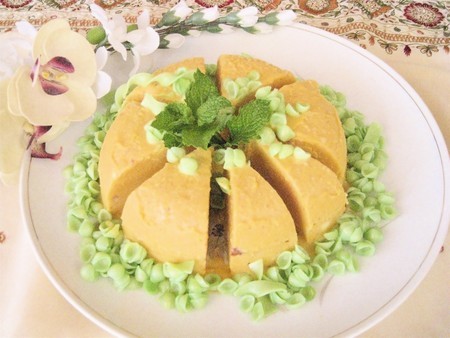The Original Fusion



Indian food in a nutshell? Well, that would be one heck of a nut.
"Indian food is difficult to characterize," said Devinder Saini, a partner in Origin India, 4480 Paradise Road. "It essentially goes back a long time."
A long time? How about to 7,000 B.C., when people in the region were harvesting sesame seeds and eggplant and domesticating humpback camels. By about 3,000 B.C., Saini said, turmeric, cardamom, black pepper and mustard seeds were being used in cooking.
"The basic Indian cuisine sort of merged from there," Saini said.
There actually were quite a few merges along the way. At the time, Saini said, the subcontinent was heavily forested; rudimentary agricultural pursuits were augmented by hunting and by foods such as honey and dairy products.
"Then, with the advent of various religions, the country basically got into vegetarianism," he said, which led to ayurveda, the system of traditional medicine that outlined a balance of foods as a basis for good health.
Following the principles of ayurveda, said Las Vegas resident Uma Aggarwal, one should have a balance of different tastes in one’s food — salty, sweet, sour, pungent, bitter and astringent.
"If these tastes are used in a proper manner, in a combination, then you stay healthy and you digest the food properly and you stay away from disease," she said.
When Aggarwal, a local resident since 2002, decided to write a cookbook dedicated to Indian cuisine, it was with a twofold purpose: to pass on both the dishes and their health benefits to generations that would follow. The result is "The Exquisite World of Indian Cuisine," which was published in India and is available at www.Amazon.com or by e-mailing her at aggarwaluma@hotmail.com.
"My kids are first-generation American," said Aggarwal, a retired chemist. "I wanted to bring to their lives the importance of the Indian cuisine, because it has a tremendous amount of health benefits because of the spices used. Not only do they make the food tasty, but have a great bonus on the side if the spices are used in proper balance."
Aggarwal also was inspired by the classes she taught at the College of Southern Nevada.
"The interest of the students really prompted me to write this book," she said.
The result is 477 pages because, well, there was a lot of ground to cover.
"The essence of Indian food is that it brings a vast variety of different cultural influences into it," Aggarwal said. "India has 28 states, and each state has its own official language and own cuisine."
"Indian cuisine tends to be a little fusiony, because it always has been," Saini said. "India’s been a melting pot for thousands of years. People from various parts of the world have gone there or returned there." As a result, cuisines from all over have been absorbed, he said.
And where on the subcontinent the immigrants/invaders settled left marks on the cuisine characteristic of the various regions. The north, Aggarwal said, was flavored by the Moguls, who brought lamb, chicken, nuts and dried fruits.
"With them came the tandoori chicken, the kebabs, kormas, biryanis, desserts like baklava and other things," Aggarwal said. "Prior to that, the food in the north was prepared with the belief that eating meat is not good for mental and spiritual well-being."
The southern region, Aggarwal said, was influenced by spice traders. "Invaders who came did not make their homes there because it’s very hot and humid in that part of the country." Southern Indian cuisine is mainly vegetarian, she said.
Chilies — which many people consider a requisite element of Indian cuisine — are relatively new to India, Saini said.
"The British introduced the chilies; they came from Latin America" 200 to 300 years ago, he said. "They took off like wildfire in India, excuse the pun. Before that we basically used black pepper. They permeated the cuisine along with potatoes and tomatoes," also introduced by the British.
"It doesn’t matter what it is; if it’s good, we use it," he said with a laugh.
The diversity, Saini said, "does make it very difficult to characterize Indian food."
Most of the Indian restaurants around the world, he said, tend to be of the northern Indian style.
"It tends to use a lot of dairy products and flatbreads, which is very similar to the Middle Eastern cuisine," he said. "It’s easily recognizable; it’s easy to understand, a little more palatable" to Western tastes.
Jitu Patel, owner of India Oven, 2218 Paradise Road, agrees that north Indian food is the most popular here, "because of its varieties on the meat side, kebabs and all. Plus, you also have a bread. The south Indian food is mostly rice. Americans are not rice-eaters. They can have rice, but not like south Indians or Chinese, who want to have rice, rice, rice."
Patel, who has been a Las Vegas restaurateur for 10 years, said one thing that characterizes Indian food in general is that it’s fairly substantial.
"It fills you up," he said. "You feel like what you’re paying for, you get the value of it. You don’t want to eat something in a half-hour or so."
But the main characteristic, Aggarwal said, is the diversity. Indian cuisine, she said, "truly offers a mind-boggling variety of food. The Moguls, Persians, Russians and Greeks influenced strongly numerous dishes popular in India even today."
INDIAN ICE CREAM
(Kulfi faluda)
2 cups whole milk
2 tablespoons arrowroot powder, dissolved in water
2 cups heavy cream
3/4 cup sugar
1 cup dry milk powder (from package to make quart)
1 tablespoon shredded almonds
1 tablespoon shredded pistachios
2 to 3 drops kevra essence (see note)
1/2 cup small mango pieces (optional)
Faluda (corn-flour vermicelli), as needed (see note)
Boil the milk in a heavy-bottomed saucepan for a few minutes; add to it the dissolved arrowroot powder and stir well to blend. Cook for 2 minutes. Add the heavy cream and stir to mix.
Add the sugar and the dry milk powder. Stir and remove from heat. Cool
Add the shredded almonds, shredded pistachios and kevra essence. Add the mango pieces, if you wish.
Blend everything well and pour into molds.
Tightly close the molds and lay them side-by-side in a box and put them in the freezer. It takes 3 to 4 hours to set.
Serve the kulfi with faluda, or plain.
Note: Kevra and faluda are available at Indian markets.
Serves 8 to 10.
GROUND MEAT KEBABS (SEEKH KEBABS)
1 teaspoon cumin seeds
1 tablespoon coriander seeds
1 tablespoon ground almonds
1 teaspoon ground poppy seeds
1 1/2 pounds lean ground beef or lamb
1/2 pound ground turkey or pork
2 tablespoons lemon juice (divided use)
1 1/2 teaspoons salt
1/2 cup chopped onion
1 tablespoon ginger
1 tablespoon garlic
1 tablespoon green chilies, chopped
1 tablespoon chopped raw mango or raw papaya
1/2 to 1 cup gram flour (chickpea flour) or breadcrumbs
2 tablespoons yogurt
1 teaspoon red pepper (optional)
1 teaspoon black pepper
1 teaspoon garam masala
1 1/2 tablespoons chopped fresh cilantro
Mint chutney for serving
2 tablespoons ground roasted cumin powder for serving
Garam masala for serving
Sliced onion for serving
A few mint leaves
Roast cumin seeds, coriander seeds, almonds and poppy seeds on a hot skillet and grind the mixture. Set aside.
Mix the ground beef with the ground turkey, 1 tablespoon lemon juice and salt and let it marinate for a couple of hours.
Add to the meat the chopped onion (with any water squeezed out), ginger, garlic, green chilies, mango, gram flour, yogurt, red pepper, black pepper, ground spice mixture (from the first step), garam masala and cilantro. Add water to make the mixture a little sticky, if needed.
Divide the mixture into 30 equal parts and pass a skewer through each of them, folding the mixture around the skewer. Leave them on the skewers for 10 to 15 minutes before grilling on a charcoal or gas grill. Or, broil them in an electric oven until light brown, with the skewers on a rack over a lined baking dish so the fat can drain. Keep turning them around the skewers until they are browned and done. Brush them with a little oil or ghee during cooking.
Serve them with mint chutney sprinkled with ground roasted cumin powder, garam masala, slices of onion, mint leaves and remaining 1 tablespoon lemon juice.
(These go well with a drink and make an excellent hors d’oeuvre.)
Serves 8 to 10.
Recipes from "The Exquisite World of Indian Cuisine," by Uma Aggarwal (available at http://www.the exquisiteworldofindiancuisine.com/ and www.amazon.com)
GRILLED CHICKEN IN GRAVY
(Murg tikka masala)
For the marinade:
1 1/2 cups yogurt
2 tablespoons lemon juice
1 teaspoon salt
1 teaspoon red pepper
2 tablespoons vegetable oil
2 pounds chicken breasts, legs or thighs, skinless
For the curry sauce:
2 cups chopped onions
2 tablespoons ghee or vegetable oil
1 tablespoon chopped ginger
1 tablespoon chopped garlic
1 teaspoon green chilies
1 teaspoon cumin seeds
1 15-ounce can tomato sauce
1/4 cup water
1 teaspoon turmeric
1 tablespoon coriander powder
1 tablespoon dry fenugreek leaves
1 teaspoon red pepper
2 tablespoons sesame seeds, ground and roasted
Salt, to taste
1/4 cup cream
1 teaspoon garam masala
1 tablespoon ground roasted cumin powder
2 tablespoons chopped cilantro
Prepare the marinade by mixing the yogurt with the lemon juice, salt, red pepper and oil. Marinate the chicken pieces overnight, or for at least a couple of hours. Broil them in the oven in a grilling pan or on an outdoor grill, until light brown, and set aside.
Cook the onions in the ghee and add the ginger, garlic and green chilies, and fry until light brown. Add the cumin seeds and cook until they pop.
Add the tomato sauce and water and mix.
Add the turmeric, coriander, fenugreek, red pepper, sesame seeds and salt. Cook the mixture for 5 minutes, until the oil starts to separate from the sauce.
Add the chicken pieces and cook them for about 5 minutes on low heat and coat them well with the sauce. Add cream and cook for another 5 minutes.
Serve garnished with garam masala, ground roasted cumin powder and cilantro. Serves 8.
Contact reporter Heidi Knapp Rinella at hrinella@review journal.com or 702-383-0474.












